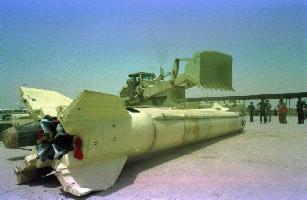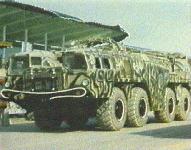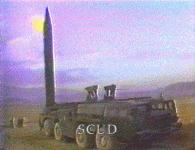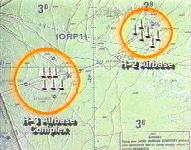





 The first upgrade, called the al-Husayn had a range of 600-650 km, allowing strikes on
Tehran. This rocket was modified through a reduction of the payload to approximately 300 to 350 kilograms. Some 11.20 meters in length and 0.90 meters in diameter, the Al Hussein corresponds more or less to the SCUD-B (length: 11.50 meters; diameter: 0.88 meters). The al-Husayn would also put most of Israel and all of Syria within
striking range. Sixty of these missiles were fired at Saudi Arabia and Israel during January and February 1991.
The first upgrade, called the al-Husayn had a range of 600-650 km, allowing strikes on
Tehran. This rocket was modified through a reduction of the payload to approximately 300 to 350 kilograms. Some 11.20 meters in length and 0.90 meters in diameter, the Al Hussein corresponds more or less to the SCUD-B (length: 11.50 meters; diameter: 0.88 meters). The al-Husayn would also put most of Israel and all of Syria within
striking range. Sixty of these missiles were fired at Saudi Arabia and Israel during January and February 1991.
In late March 1990, there were press reports that Iraq had completed construction of six fixed-site missile launchers for its al-Husayn missiles at the H-2 airfield in western Iraq, near the Jordanian border. (1) Although a fixed launcher provides for greater accuracy than a mobile launcher, it is also much more vulnerable to attack. The majority of Iraq's Scud and Scud-variant missiles were launched from mobile transporter-erector-launchers, or the towed al-Waleed launcher.
In its efforts to extend the range of the imported SCUD B missiles, Iraq used simple techniques which did not add significantly to its missile technology base. However, its reverse-engineering efforts included the acquisition of sophisticated production machinery and technology as well as the acquisition from various suppliers of components for missile systems. In particular, Iraq gained expertise in missile propulsion systems and their propellants, guidance and control and airframe production technologies, and acquired the hardware for high-precision machining. Iraq was not successful in its efforts to acquire an indigenous capability to produce indigenously entire missile systems through its reverse-engineering efforts. [S/1995/284] Following the successful development of the Al Hussein from imported SCUD missiles, Iraq undertook to produce indigenously these missiles. Iraq procured, through importation, the necessary components, production equipment and tooling. In early 1990, Iraq established a production goal of 200 missiles. Iraq intended to eventually produce 1000 missiles. By April 1991, Iraq had made significant progress in its indigenous production efforts. Iraq successfully manufactured and tested virtually all major components for its indigenous missiles with the exception of gyroscopes. Iraq had contracts for the foreign procurement of gyroscopes. It also retained some original imported gyroscopes until the last quarter of 1995. Iraq conducted 12 static tests and four flight tests of indigenously produced engines. Several of these tests were successful. [UNSCOM] In 1988, Iraq initiated the development of a supersonic parachute recovery system for the Al Hussein missile warhead. The programme continued through 1990. Iraq approached at least three different companies for the development, production and supply of the system. However, no systems were provided to Iraq. [S/1995/284]A variant of the Al Husayn was also produced, known as the Al Husayn Short. According to unconfirmed information of October 1990, Iraq was producing missiles for use against oil wells and people. The "Al Hijarah" missiles would release poison clouds that would kill personnel on the ground and ignite oil wells. The Iraqis claimed to have fired at least one of another SCUD variant, the Al Hijarah, which apparently had a concrete-filled warhead, at Israel during Operation Desert Storm. A total of four or five of these Al Husayn missile variants were probably fired during the Gulf War, including at least one Al Hijarah which landed in the Negev Desert near the Israeli nuclear facility near Dimona.
As of 1996 UNSCOM maintained that Iraq was still concealing six to sixteen enhanced Scud missiles, potentially able to deliver chemical or biological warheads. These Al Hussein missiles eluded UNSCOM inspectors, along with as many as 20 long-range missile warheads produced before 1991 specifically to carry biological weapons. By 1996 UNSCOM concluded that Iraq had produced 80 Scud-like missiles indigenously -- thereby placing in doubt UNSCOM's initial overall count of Iraq's original missile inventories. UNSCOM teams visiting in 1996 were unable to locate hidden missiles but UNSCOM continued to investigate Iraq's methods of concealment.
In mid-1996, a general officer defector from Iraq said that he believed Saddam Hussein had retained some 40 Scud-type missiles. After UNSCOM unwillingly withdrew from Iraq in 1998, some estimated that Iraq could resume production of Al Hussein missiles within one year. According to a United States government white paper in 1998, Iraq maintained a small force of Scud-type missiles and may have pieced together Scuds by integrating original guidance and control systems it concealed from UNSCOM with parts produced in Iraq.
In February 2000 Uzi Rubin, a member of Israel's National Security Council and former head of Israel's Homa anti-missile defence program, aserted that Iraq had 50 Al Hussein missiles. He told the Israel Annual Conference on Aerospace Sciences on 24 February that the Iraqi regime had managed to conceal the missiles, which could be deployed at short notice. [Jane�s Defence Weekly, March 1, 2000]
Developing Nations and Warhead Dynamic Performance
Recently, it was suggested that the developing nations missile program warheads would be tumbling about their center of gravity during re-entry, which would then make it difficult to identify. This was because they were not being spun-up along their longitudinal axis prior to re-entry through the atmosphere.
A warhead is much like a bullet fired from a rifle barrel. If the barrel is grooved to spin up the bullet along its longitudinal axis it tends to fly through the atmosphere to its target more smoothly and accurately. If the barrel is not built with this capability, the bullet tumbles uncontrollably about its center of gravity throughout its flight in the atmosphere to its target. This tumbling reduces the accuracy of the projectile.
This kind of missile warhead tumbling was noted in the ballistic flights of Iraqi's Scud-B, Scud-C/Al-Hussein, Scud-D/Al-Abbas ballistic missiles during the Gulf war. In this particular case all of the warheads remained attached to the Scud derived rocket bodies. The length of the Scud-C and D missile bodies and the failure to spin up either the missile with its warhead or separate the warhead after missile spin up made them extremely unstable and in accurate during re-entry to their target.
Today this is not the case with North Korean derived warhead technology. North Korea successfully demonstrated payload spin up with the satellite launch attempt of the Taep'o-dong-1 or PAEUTUSAN-1 booster. The Paeutusan-1 solid propellant third stage both demonstrated a near full duration burn and the spin up of the stage and satellite along its longitudinal axis. However, the third stage solid motor ruptured, de-orbiting the satellite, almost immediately after orbital insertion while achieving orbital velocity.
Therefore, it would be correct to assume that besides North Korea's, No-dong (first stage of Taep'o-dong-1), both Pakistan's Ghauri-II and Iran's Shahab-3 all benefit from this spin-up technology. The Shahab-3/Ghauri-II both apparently spin up the single booster stage and warhead combination starting at about 10 seconds before the termination of the powered flight at 110 seconds. At this point after 110 seconds of powered flight the warhead is then separated from the booster stage to fly on a re-entry trajectory that remains stable to its target. With the addition of GPS targeting the warhead accuracy is greatly enhanced. There are still many in the analytical community that question, perhaps correctly, this suggested accuracy of 190 meters to over one kilometer. There can be no doubt that this spin-up technology does improve the accuracy of these warheads over the previously demonstrated poor capability. Since the warheads are not tumbling it in fact enhances the interceptor sensor signature identification capability verses that of a tumbling warheads signature.
Equally revealing is the fact that this is the area where the Iranian Shahab-3 has repeatedly failed in flight test. If the steering vains are not equally positioned correctly or are defective in any way the missile and warhead combination would tumble about its center of gravity out of control destroying the missile. The resulting tumbling warhead whether attached to the remaining missile body or not would in all probability be destroyed during its re-entry. It is known that Iran has and continues to suffer from a steering vain quality control problem for its Shahab-3 ballistic missile that the Germans during WW-II solved and that the United States and former Soviet Union were able to easily resolve with out using specialized coating.




